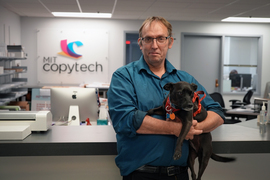A lot of behind-the-scenes work goes into creating an art installation or a theater production – not just by those making or performing their craft, but also by the staff members who coordinate the logistics of exhibits and events. One of the people at MIT who helps artists bring their projects to life is Lydia Brosnahan.
In her role as associate producer in the Office of the Arts, Brosnahan works with several different arts initiatives including the MIT Center for Art, Science and Technology (CAST) and the Council for the Arts at MIT (CAMIT).
“The arts at MIT are alive and well,” says Brosnahan, who has worked at the Institute for six years. “My job involves administering grants to faculty for their own artistic work as well as visiting artist residency projects where faculty members invite an artist to campus to collaborate with them, their students, and with the MIT community. Every visiting artist residency has some sort of public component, which could be an event or an activity.”
It’s a collaborative effort in the Office of the Arts and the tasks of the department do not end with grant selection, distribution, and event execution. Brosnahan’s colleagues are also involved in student art programs, with running the MIT Arts Studios classes, and with the Wiesner Student Art Gallery, which features exhibitions of artwork by MIT students.
“I also coordinate the CAMIT grants program, which primarily supports artistic projects by students,” Brosnahan explains. “Right now, for example, there is an exhibition in the Wiesner Student Art Gallery that was supported by a grant from CAMIT.
“When I tell people outside of the Institute that I work in the arts at MIT they usually respond with, ‘There are arts programs at MIT?’ I think that is kind of the general impression. Outside of our visiting artists programs, we also have public art collections, architecture...there are so many student artists who are doing it as part of their career or to enhance their degree. There are theater groups who put on productions and organizations that take part in music and dance. I want people to know that the arts here are rich and amazing.”
One of the projects Brosnahan is most proud to have worked in was part of a collaboration between CAST and the MIT Museum. “The first collaborative project that we did, that I got to help launch, was an exhibition called Arachnodrone. It's an installation that is based on research about spiderwebs and is a collaboration between engineers in civil and environmental engineering, researchers, and musicians who took the vibrational frequency of spiderwebs and turned it into music. It is both an installation and a performance.”
She also enjoys producing Arts on the Radar, a big kick-off celebration in the first week of September. “It is basically a way to say 'The arts are here. Come check them out!' We have demonstrations by students and collaborate with other arts units on campus including the List Visual Arts Center; the Art, Culture, and Technology program; the Department of Architecture; the Morningside Academy for Design; and Music and Theater Arts. We come together to throw a big party with the goal of helping people learn about what opportunities are available in the arts. It’s fun!”
Soundbytes
Q: What do you like the most about your job?
Brosnahan: The people. Every project I work on is a little bit different because everyone who comes to us has a cool idea for a project. There is never a dull moment! Often there are projects that bring together art, science, and technology in new ways. I learn a lot just from being around interesting people and projects.
Q: If someone was about to start working in MIT, what advice would you give them?
Brosnahan: Wander around campus. Get lost, explore, and try to meet people from every corner of MIT. When you start working here, there is a rush of new things to learn. It’s beneficial, and just great, to learn about everything going on here. I still find myself walking around, getting lost on campus, and discovering a different research lab I didn’t know about.
Q: Are you involved in any groups or clubs offered to staff members outside of your job?
Brosnahan: I'm a big fan of, and participant in, the MIT Language Conversation Exchange. LCE holds language lunches where you can sit at a specific language table and practice speaking that language with language learners and native speakers. They also have a program where you get matched with partners of MIT students, staff, and faculty as a one-on-one conversation partner. You note what language(s) you speak, which you want to learn, and then you can see if someone speaks one you want to learn. I'm really into foreign languages and I was excited to learn about that opportunity and get involved in the wider community.









